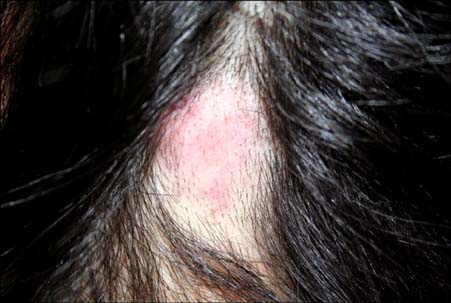Ann Dermatol.
2014 Oct;26(5):624-627. 10.5021/ad.2014.26.5.624.
Alopecia Neoplastica due to Gastric Adenocarcinoma Metastasis to the Scalp, Presenting as Alopecia: A Case Report and Literature Review
- Affiliations
-
- 1Department of Dermatology, Kyung Hee University College of Medicine, Seoul, Korea. bellotte@hanmail.net
- KMID: 2265500
- DOI: http://doi.org/10.5021/ad.2014.26.5.624
Abstract
- Alopecia neoplastica is defined as hair loss secondary to a visceral malignancy that has metastasized to the scalp. The scalp is a relatively common site of cutaneous metastasis, usually presenting as a single or multiple firm scalp nodules. Alopecia neoplastica is a well-recognized but rare presentation, and its pathogenesis is incompletely understood. Atrophy of the hair follicles due to tumor invasion of the scalp plays a role in the development of alopecia. Herein, we describe a 33-year-old woman with gastric adenocarcinoma who developed alopecia neoplastica while receiving cancer chemotherapy. Scalp biopsy revealed metastatic adenocarcinoma cells interspersed between collagen bundles and around hair follicles. Immunohistochemical analysis indicated that the tumor cells originated from the primary gastric adenocarcinoma. Therefore, she was diagnosed with alopecia neoplastica due to gastric adenocarcinoma. The findings from this report may be helpful for understanding the mechanism of alopecia neoplastica.
MeSH Terms
Figure
Cited by 1 articles
-
Clinicopathologic features of cutaneous metastases from internal malignancies
Hyeong Mok Kwon, Gyu Yeong Kim, Dong Hoon Shin, Young Kyung Bae
J Pathol Transl Med. 2021;55(4):289-297. doi: 10.4132/jptm.2021.05.24.
Reference
-
1. Brownstein MH, Helwig EB. Patterns of cutaneous metastasis. Arch Dermatol. 1972; 105:862–868.
Article2. Bergfeld WF. Hair disorders. In : Moschella SL, Hurley HJ, editors. Dermatology. 3rd ed. Philadelphia: W.B.Saunders Company;1992. p. 1551–1552.3. Wang D, Zhou J, Wang T, Li X, Li S, Chen S, et al. Polymorphisms in MSH2 gene and risk of gastric cancer, and interactions with lifestyle factors in a Chinese population. Cancer Epidemiol. 2012; 36:e171–e176.
Article4. Lookingbill DP, Spangler N, Sexton FM. Skin involvement as the presenting sign of internal carcinoma. A retrospective study of 7316 cancer patients. J Am Acad Dermatol. 1990; 22:19–26.5. Gül U, Kiliç A, Akbaş A, Aslan E, Demiriz M. Alopecia neoplastica due to metastatic colon adenocarcinoma. Acta Derm Venereol. 2007; 87:93–94.
Article6. Sgambati SA, Barrows GH. Cutaneous metastasis of colon carcinoma: a case report. Conn Med. 1993; 57:665–667.7. Proffer LH, Czarnik KL, Sartori CR. Colon carcinoma cutis: a case report. Cutis. 1999; 63:301–302.8. Kim HJ, Min HG, Lee ES. Alopecia neoplastica in a patient with gastric carcinoma. Br J Dermatol. 1999; 141:1122–1124.
Article9. Chae YS, Suh KS, Kim ST. Alopecia neoplastica due to breast cancer. Ann Dermatol. 1990; 2:89–92.
Article10. Oh JU, Park JI, Kim HO, Park SR. A case of alopecia neoplastica metastasis from breast carcinoma. Korean J Dermatol. 1999; 37:225–228.11. Conner KB, Cohen PR. Cutaneous metastasis of breast carcinoma presenting as alopecia neoplastica. South Med J. 2009; 102:385–389.
Article12. Haas N, Hauptmann S. Alopecia neoplastica due to metastatic breast carcinoma vs. extramammary Paget's disease: mimicry in epidermotropic carcinoma. J Eur Acad Dermatol Venereol. 2004; 18:708–710.
Article13. Choi HB, Rho JH, Joh OJ, Park SR, Song KY. A case of alopecia neoplastica from breast cancer. Korean J Dermatol. 2005; 43:1416–1418.14. Kohno A, Saruta T, Kimura H. A case of alopecia neoplastica due to cutaneous metastasis from stomach. Rhinsho Derm. 1983; 25:334–335.15. Yuen YF, Lewis EJ, Larson JT, Wilke MS, Rest EB, Zachary CB. Scalp metastases mimicking alopecia areata. First case report of placental site trophoblastic tumor presenting as cutaneous metastasis. Dermatol Surg. 1998; 24:587–591.16. Cohen I, Levy E, Schreiber H. Alopecia neoplastica due to breast carcinoma. Arch Dermatol. 1961; 84:490–492.
Article17. Murakami H, Nakanishi H, Tanaka H, Ito S, Misawa K, Ito Y, et al. Establishment and characterization of novel gastric signet-ring cell and non signet-ring cell poorly differentiated adenocarcinoma cell lines with low and high malignant potential. Gastric Cancer. 2013; 16:74–83.
Article18. Johnson WC. Metastatic carcinoma of the skin. In : Elder D, Elenitas R, Jaworsky C, Johnson B, editors. Lever's histopathology of the skin. 10th ed. Philadelphia: Lippincott;2009. p. 1155–1156.19. Archer CB, Smith NP. Alopecia neoplastica responsive to tamoxifen. J R Soc Med. 1990; 83:647–648.
Article20. Scheinfeld N. Review of scalp alopecia due to a clinically unapparent or minimally apparent neoplasm (SACUMAN). Acta Derm Venereol. 2006; 86:387–392.
Article




